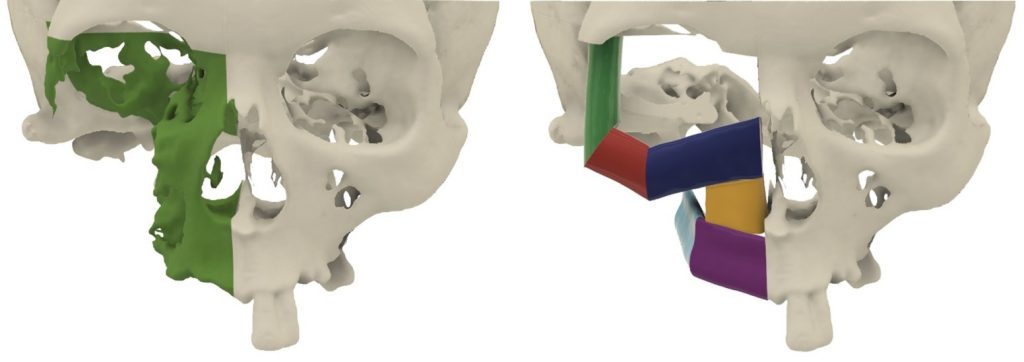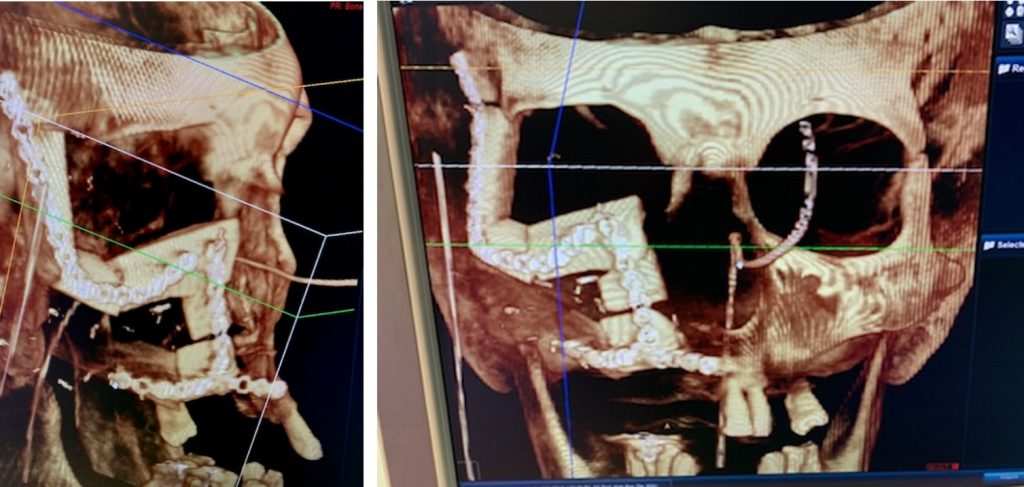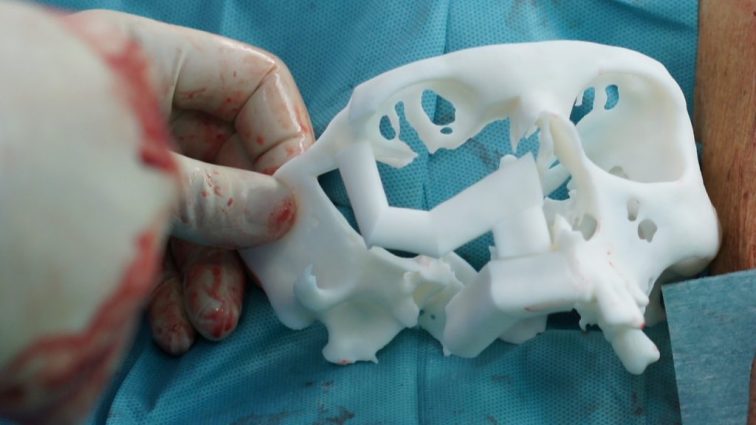At the end of October 2018, the experienced orthopedics team of the Oncologic and Reconstructive Surgery Clinic of the Cancer Center in Gliwice, Poland, led by Dr. Łukasz Krakowczyk, conducted a very extensive maxillofacial tumor resection followed by a reconstruction of the bone defect using a vascularized free fibula flap.
The 57-year-old female patient was diagnosed as having the malignant tumor of the right maxillary sinus. The aggressive and spreading quickly squamous cell carcinoma (tumor grade G3) resulted in radical surgical treatment of the entire right part of the patient’s face. In the tumor resection, the entire tumor in the maxilla with the nasal bone, zygomatic bone, orbital floor and a margin of normal-looking tissue around it, was removed. The margin of normal tissue was taken out to reduce the chance of any cancer cells being left behind. Such extensive defects can have severe functional and cosmetics consequences. The surgeons decided to reconstruct the patient’s bone defect using 6 autologous bone transfers harvested from the right fibula with two pieces of muscle cuff and a skin island. The key aspect of the reconstructive surgery was to vascularize free fibula flaps with facial vessels by microvascular surgery (sewing together small blood vessels under a microscope using endovascular staplers).

Virtual pre-operative planning and 3D-print
Such complex reconstructive surgery of midfacial defects requires the use of virtual planning techniques with rapid prototyping. During the pre-operative planning, Customy collaborated closely with Dr. Krakowczyk, world-class specialist known from performing pioneering face transplant surgery for lifesaving reasons. Based on a CT scan of the patient’s face Customy created a 3D virtual patient’s model to allow the surgeon to plan the tumor resection. According to the surgeon guidelines, Customy designed the reconstruction of the face defect by planning the length and angles of the right fibula osteotomies, taking in consideration the optimal length of the vascular pedicle of the flap. In addition, during pre-operative planning the distance of proximal and distal osteotomies of the fibula had been considered to avoid inception of ankle and knee joint dysfunctions.

As the result, Customy provided the patient-specific reconstruction set containing custom-made cutting guide for the fibular bone, 3 stereolithographic models of the midface before the surgery, the final reconstructed midface and the fibula. The cutting guide had been made from biocompatible material and after the sterilization process was used during the surgery. The guide helped the surgeon to harvest the free fibula flap according to the preoperative plan.
The anatomical models were used as a reference for pre-operative planning and used during the surgery to increase the accuracy. A reconstructive plate had been bent according to the model of the final reconstructed midface to decrease the duration of the surgery. After tumor resection, that model had also been used as a guide for the surgeon to place the bone graft taken from the fibula.

The advanced tumor stage enforced a very short period of time for surgery planning and manufacturing the three-dimentional models and guides by Customy. From receiving the CT scan to delivery to the hospital the ready-to-use custom-made reconstructive set passed only 5 days.
The surgery was conducted by two teams working simultaneously with the patient. The first team was responsible for tumor resection, and the second team was working on midface reconstruction from the free vascularized fibula flap and the reconstructive plate.
The detailed steps of the surgical technique are outlined below:
- tumor resection – the lesion is resected with safe margin and with the orbital floor,
- fitting the cutting guide first on the fibula model and then on the fibula bone in donor site,
- osteotomies on the fibula by use of the cutting guide,
- detaching the free fibula flap from the donor site,
- inserting the fibula graft in the mandibular region and making the micro-anastomoses to preserve the flap viability,
- fixation of the reconstruction flap with screws,
- the nasal passage reconstruction by using the part of the skin of the flap,
- the palate reconstruction.
Results
The use of the patient-specific reconstruction set allowed to increase preoperative planning accuracy, resulting in greater surgical precision and obtaining good functional and aesthetic results. As well as, allowed to reduce the surgical duration by around 3 hours. The procedure was 7-hour long and the reduced intraoperative time reduce surgical cost and complications.
The reconstruction of mandibular defects is very complex due to the need to address both functional and aesthetic objectives. Using the 3-dimentional virtual planning of resection and reconstruction followed by surgery with the use of 3D printed models and cutting guides is the current standard of care in the reconstructive surgery.





